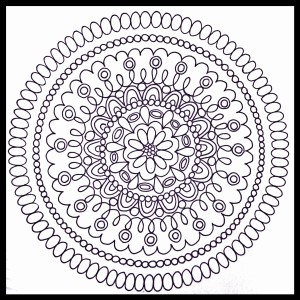
The Mandala (Sanskrit for “circle” or “completion”) has been around for a long time and has been used across many cultures. It is recognised for its spiritual meaning and as a representation of wholeness.
Christians, Buddhists, Tibetans, and Hindus have all gained meaning from the captivating beauty of the mandala. The psychoanalyst Carl Jung enjoyed creating mandalas and he called it “a representation of the unconscious self.” Mandalas are reflected in the natural world around us. The radiating pattern of petals in flowers are a perfect example of this.
The creation of mandalas as a form of art therapy can be a wonderful way to reflect on one’s soul, gain insight and facilitate healing. It is a powerful tool to help ease stress and anxiety, as it focuses the minds attention inwardly and allows the fear centres of the brain to “take a holiday.”
Creating your own mandala is very therapeutic and symbolic. The colours, shapes and patterns you use in your mandala reflect your inner self at the time of creation. Whatever you are going through at the time will be represented in your artwork. You are ultimately creating a portrait of yourself as you design your mandala.
As with all art therapy activities, creating a mandala is not about the finished product but about the process. While you are making your mandala, allow yourself to let go of all outside distractions and how you think things “should” be, and just be present in the moment and enjoy a sense of “flow” (where you are so engaged in an activity that you lose all track of time).
To create a Mandala you will need:
- A square piece of paper/canvas/card
- Drawing materials. You can use anything you like for this. You might like to use pencils, felt markers, paints, water colours, charcoal, pen etc.
- A compass or something round to trace around (e.g. place, frying pan, bucket).
- A quite place to work that is relatively free from distractions
Once you have gathered your materials you can start creating.
Firstly, draw a circle in the centre of your square paper. The circle represents wholeness, integrity and  the unity of the body and mind. By placing the circle in the centre of the square paper it helps to frame your mandala, but it is also more pleasing to the brain.
the unity of the body and mind. By placing the circle in the centre of the square paper it helps to frame your mandala, but it is also more pleasing to the brain.
There are no rules to constructing a mandala, although it is useful to stay roughly within the circular shape. Many people find the blank circle a little daunting when getting started. To overcome this, I always begin my mandala from the centre and work my way out to the edges as this helps me to focus my attention and allow my feelings to inspire my design.
Once you have finished your mandala, you might like to date it and give it a title. Examine your artwork and take note of the predominant colours you have used, the shapes/patterns drawn, and areas of contrast in your design, the feelings that your mandala evokes. Think about how you felt or any memories that surfaced while you were drawing your mandala and write them down. Can you see any connections or representations in your mandala?
Creating a mandala is a very personal and introspective activity and process, so the results are bound to vary. It is important to recognise that your mandala is a reflection, of who you were when you created it. Ideally, the process of creating the mandala results in some form of self-healing, self-expression, and/or self-exploration.
You can also create mandalas with collected materials (e.g. sticks, leaves, flowers, buttons etc.) or using collage techniques. You are really only limited by your imagination.
If you would like to learn more about mandala drawing, The Cr3ative Space runs workshops that incorporate mandalas and mindfulness strategies to help with stress and anxiety management.
I would love to see some of your mandala creations, so feel free to share them below or hashtag #thecr3ativespace on Instagram and Facebook.
![]()

Comments: no replies